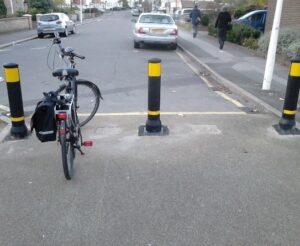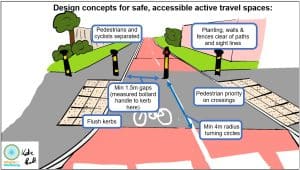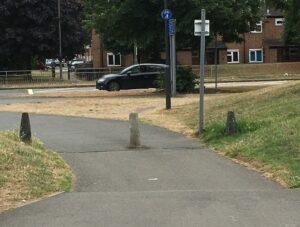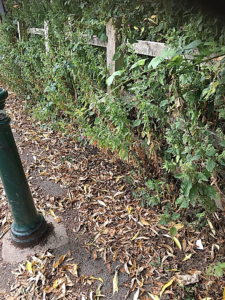Introduction
The minimum standard of infrastructure that’s considered acceptable for people walking, wheeling and cycling is changing rapidly. This is really good news for Disabled people and others who need improved accessibility, as the changes mean that new and refurbished public spaces should become much more usable for us in future years.
But we know it’s a lot to take in for people involved in creating schemes – and there are both legitimate concerns and understandable misconceptions that we need to talk about.
At Wheels for Wellbeing we’re releasing a series of guidance sheets for local authorities, NGOs, other organisations involved in decisions about walking, wheeling and cycling schemes and for anyone with an interest in active travel infrastructure. Hopefully, these guidance sheets will help explain the reasoning behind different aspects of accessible infrastructure design.
These guidance sheets are aligned with our Guide to Inclusive Cycling (5th edition due autumn 2023). They may be printed, electronically distributed or quoted provided credit is given to Wheels for Wellbeing.
Download the vehicle access restriction bollards guidance sheet as a Word document
Download the vehicle access restriction bollards guidance sheet as a pdf
When to use bollards:
Bollards may be used when other measures to prevent dangerous vehicle access have proven ineffective:
All access controls including bollards are obstacles that make a path less safe and less accessible for legitimate users.
Bollards spaced with an absolute minimum air gap of 1.5m and straight approach will prevent vehicle access:
- All modern cars are over 1.6m wide.
- Cycles and other mobility aids can be up to 1.2m wide.
- People being guided by assistants or assistance dogs, people in groups (including accompanying children), with pushchairs and carrying shopping can need even more width.
- Design and maintenance (vegetation/litter) must ensure usable access widths never drop below 1.5m.
- Bollards should only ever be installed on straight, level, smooth, sealed surfaces.
Using bollards:

Bollards must be at least 1m high, contrast with their surroundings & have reflective bands for visibility.
Bollards must have minimum 1.5m straight-line access widths, assuming 4m turning radius for larger cycles and mobility aids

Legal & guidance position on access barriers:
Equality Act (2010):
These duties are anticipatory: All reasonable adjustments to make a space equitably accessible for Disabled people legally must be taken without any Disabled person having to ask for them.
Section 20: Requires those responsible for a space to anticipate and make reasonable adjustments to enable Disabled people access with no substantial disadvantage compared to non-Disabled people. This explicitly includes including altering and removing physical features which would otherwise exclude Disabled people.
It is not permitted to require a Disabled person to go a longer way around, ask for assistance or traverse a space much more slowly than a non-Disabled person would have to due to a physical barrier that could be removed.
Section 149 Public Sector Equality Duty: Requires public authorities to advance equality of opportunity for all people with protected characteristics, including Disabled people.
This goes beyond removing and minimising disadvantages, and additionally includes taking steps to promote equality by actively enabling Disabled people to participate in public life and activities, especially where Disabled participation is disproportionately low (e.g. active travel).
Cycle Infrastructure Design LTN 1/20:
Section 1.6 summary principle 16: “Access control measures… should not be used. They reduce the usability of a route for everyone, and may exclude people riding nonstandard cycles and cargo bikes. They reduce the capacity of a route as well as the directness and comfort. Schemes should not be designed in such a way that access controls, obstructions and barriers are even necessary”.
More considerations:

Small bollards with low contrast and no reflective bands are hard to see, making them a dangerous obstacle for path users

Vegetation growth and debris on paths will block access without careful design and sufficient maintenance.
References/Further reading/Resources:
- Equality Act (2010): https://www.legislation.gov.uk/ukpga/2010/15/contents
- LTN 1/20 Cycle infrastructure design: https://www.gov.uk/government/publications/cycle-infrastructure-design-ltn-120
- Wheels for Wellbeing Guide to Inclusive Cycling (4th edition, 2020): https://wheelsforwellbeing.org.uk/campaigning/guide/
